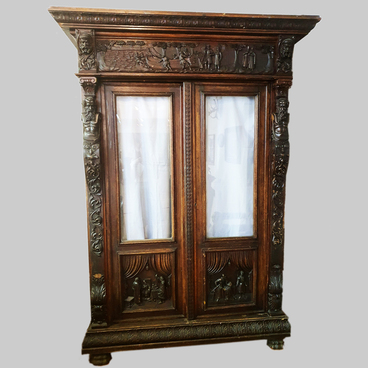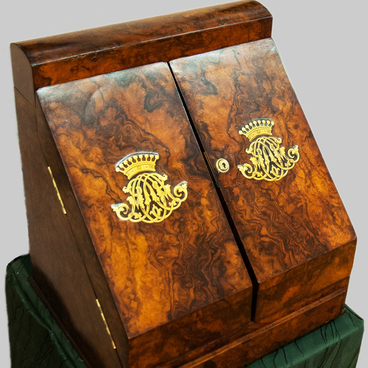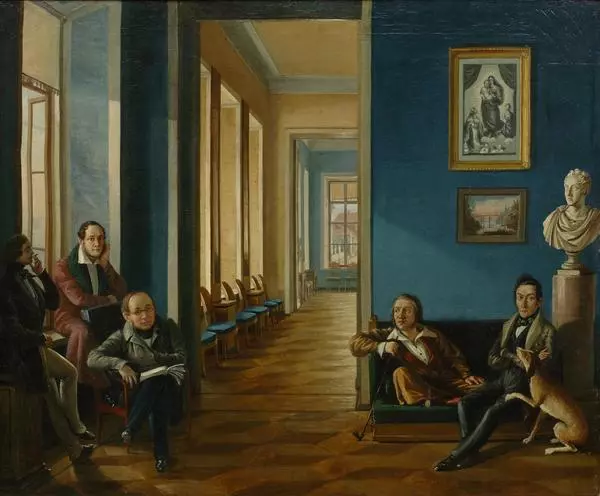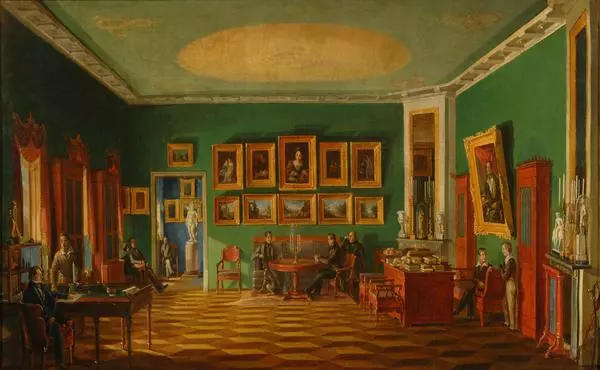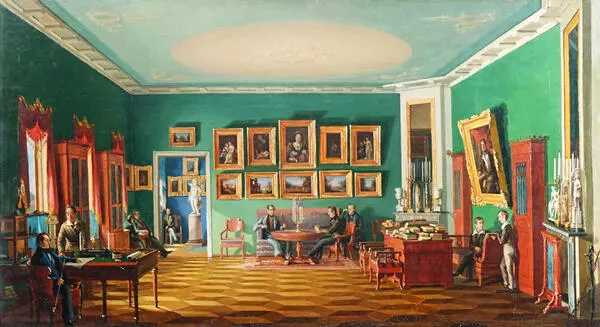The painting was made using the staffage technique, which was quite popular in landscape artworks of the 16th and 17th centuries. At first, the technique was used in paintings with mythological and religious themes. Staffage, or decoration with figures, is placement of a group of people or animals with no plot meaning in the landscape.
Figures are often so small and unrelated to the painting that one could do without them altogether. In our case, the artist creates a picture in which staffage becomes the semantic core of the plot. The plot is naive and somewhat theatrical, with obvious allusions to the iconography: the artist came from an icon painting family. At the same time, the picture emanates the serenity and stability of the noble life. In a few decades, the world will change, changing the fate of many. But right now they are all together, and they are happy. To ‘bring together’ all these people, the author copied the faces from the existing portraits and then finished drawing the figures in the poses he needed.
The painting was created by Nikolai Ivanovich Podklyuchnikov. He was born into a family of serfs belonging to Count Sheremetev in 1813. Descended from the artistic family of Ivanovs-Shirokovs-Podkyuchnikovs. Nikolai’s family lived in Ostankino.
Since 1832, Podkyuchnikov attended the Art Lovers Club (also called the Natural Class) where three artists taught people their craft. Each member of the club pitched in to keep the club afloat. In 1833, the Natural Class was renamed the Moscow Art Class, and later —the Moscow School of Painting, Sculpture, and Architecture.
Podklyuchnikov’s earliest work, ‘View of the Ostankino Estate, ’ is dated 1833. Six years later, Podklyuchnikov was supposed to receive the title of a free artist for his painting ‘View of the Church of St.Basil the Blessed in Moscow from the Moscow River’, but a serf could not claim such a title.
Podklyuchnikov received his freedom in 1839 and moved to Moscow a year later. There, he continued to educate himself, participated in exhibitions of the Academy of Arts, and met collectors and art lovers.
Nikolai also took up the restoration of paintings around that time. The iconostasis of the Assumption Cathedral in the Kremlin was his most significant restoration work.
Two of his sons, Ivan and Nikolai, also became artists. He taught Ivan’s wife, Anna, the trade secrets of restoration. After the death of her husband Ivan in 1900, Anna Podklyuchnikova worked for many years at the Historical Museum with her daughter.
Figures are often so small and unrelated to the painting that one could do without them altogether. In our case, the artist creates a picture in which staffage becomes the semantic core of the plot. The plot is naive and somewhat theatrical, with obvious allusions to the iconography: the artist came from an icon painting family. At the same time, the picture emanates the serenity and stability of the noble life. In a few decades, the world will change, changing the fate of many. But right now they are all together, and they are happy. To ‘bring together’ all these people, the author copied the faces from the existing portraits and then finished drawing the figures in the poses he needed.
The painting was created by Nikolai Ivanovich Podklyuchnikov. He was born into a family of serfs belonging to Count Sheremetev in 1813. Descended from the artistic family of Ivanovs-Shirokovs-Podkyuchnikovs. Nikolai’s family lived in Ostankino.
Since 1832, Podkyuchnikov attended the Art Lovers Club (also called the Natural Class) where three artists taught people their craft. Each member of the club pitched in to keep the club afloat. In 1833, the Natural Class was renamed the Moscow Art Class, and later —the Moscow School of Painting, Sculpture, and Architecture.
Podklyuchnikov’s earliest work, ‘View of the Ostankino Estate, ’ is dated 1833. Six years later, Podklyuchnikov was supposed to receive the title of a free artist for his painting ‘View of the Church of St.Basil the Blessed in Moscow from the Moscow River’, but a serf could not claim such a title.
Podklyuchnikov received his freedom in 1839 and moved to Moscow a year later. There, he continued to educate himself, participated in exhibitions of the Academy of Arts, and met collectors and art lovers.
Nikolai also took up the restoration of paintings around that time. The iconostasis of the Assumption Cathedral in the Kremlin was his most significant restoration work.
Two of his sons, Ivan and Nikolai, also became artists. He taught Ivan’s wife, Anna, the trade secrets of restoration. After the death of her husband Ivan in 1900, Anna Podklyuchnikova worked for many years at the Historical Museum with her daughter.


